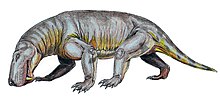Gorgonopsia
| Gorgonopsidae | ||||||||||||
|---|---|---|---|---|---|---|---|---|---|---|---|---|

Two Inostrancevia are chasing a Scutosaurus |
||||||||||||
| Temporal occurrence | ||||||||||||
| Roadium to Changhsingium ( Middle to Upper Permian ) | ||||||||||||
| 270.6 to 251 million years | ||||||||||||
| Locations | ||||||||||||
| Systematics | ||||||||||||
|
||||||||||||
| Scientific name | ||||||||||||
| Gorgonopsia | ||||||||||||
| Seeley , 1895 | ||||||||||||
| Scientific name | ||||||||||||
| Gorgonopsidae | ||||||||||||
| Lydekker , 1890 |
The Gorgonopsia were a group of therapsids ("mammal-like reptiles"). They lived in the Middle to Upper Permian 270 to 251 million years ago and were the dominant carnivores of this era. The group was named by Harry Seeley after the gorgons from Greek mythology, winged frightful figures with snake hairs that turn anyone who looks at them to stone. The Gorgonopsia were the most diverse group of Theriodontia .
All of the group's fossils were found in Africa, Russia, and China. Outside they are completely unknown. Neither form of the group survived the mass extinction at the end of the Permian .
features
The characteristic feature of the Gorgonopsiden were the saber-like enlarged canines . There were five well-developed incisors in the upper jaw and four in the lower jaw , while four or five very small, simply built teeth per half of the jaw behind the canines. The skulls were relatively primitive. The roof of the skull has an additional bone element between the frontal and the parietal, the preparietal , which is not involved in the border of the parietal foramen. The construction of the skull and the arrangement of the skull windows suggest that the jaw could be opened very wide and the animal could bite hard.
The rest of the body was elongated and had slender, long limbs that probably made it possible to run quickly. The legs arranged under the body and the differentiated ( heterodontic ) teeth are already features that point to the later development to mammals .
The phalangeal formula is 2-3-4-5-3 and thus corresponds to that of primitive reptiles.
Apart from differences in body size, the individual species differed only relatively little from one another. The earlier representatives reached the size of a small dog. The well-known species Lycaenops was around three feet long , while the last and largest gorgonopsid, Inostrancevia , was over four feet long. His prey probably included dinocephalia , dicynodontia and pareiasauria .
Systematics
External system
The Gorgonopsiden are no longer considered to be reptiles , but they form an original branch on the trunk line of mammals (Mammalia) that still has many primitive features . They form within the Therapsiden (formerly called "mammal-like reptiles") with the Therocephalia and the Cynodontia the group of Theriodontia .
The family relationships are illustrated by the following cladogram:
| Therapsids |
|
|||||||||||||||||||||||||||||||||||||||
|
|
Internal system
Within the Gorgonopsia three subfamilies are distinguished, of which, however, possibly only the Rubidgeinae are monophyletic .
-
Gorgonopsidae
- Aelurognathus
- Aelurosaurus
- Aloposaurus
- Arctognathus
- Arctops
- Broomisaurus
- Cephalicustriodus
- Cerdorhinus
- Clelandina
- Cyonosaurus
- Dinogorgon
- Eoarctops
- Galesuchus
- Gorgonops
- Kamagorgon
- Leontocephalus
- Lycaenops
- Paragalerhinus
- Scylacognathus
- Sycosaurus
- Viatkogorgon
- Gorgonopsinae
- Rubidgeinae
- Inostranceviinae
Trivia
Gorgonopsids appear several times in the television series Primeval - Return of the Primeval Monsters . In terms of size and appearance, the animals only named Gorgonopsis in the program are Inostrancevia .
literature
- TS Kemp: The Origin & Evolution of Mammals. Oxford University Press, Oxford 2005. ISBN 0198507615
- Robert L. Carroll : Paleontology and Evolution of the Vertebrates , Thieme, Stuttgart (1993), ISBN 3-13774-401-6
- Michael J. Benton : Paleontology of the vertebrates. 2007, ISBN 3899370724
- Oskar Kuhn: The mammal-like reptiles . A. Ziemsen Verlag, 2003, ISBN 3-89432-797-9
Individual evidence
- ↑ Bruce S. Rubidge & Christian A. Sidor: Evolutionary patterns among permo-triassic Therapsids. Annu. Rev. Ecol. Syst. 2001. 32: 449-80 Complete PDF
Web links
- The Paleobiology Database Gorgonopsia
- Palæos Gorgonopsia
- Gorgonopsia in Mikko's Phylogeny Archive
- Introduction to the Gorgonopsia




